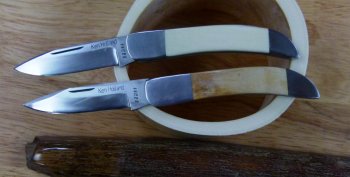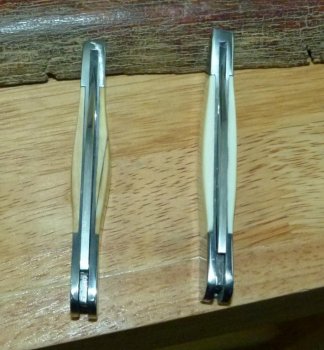Well folks - I finally got a couple more folders completed, one in mammoth and one in pre-ban elephant ivory. Both are built to the same pattern as the first, and seems like I learn something new with each knife.
Both has 416 liners 'n milled bolsters. Blade and backspring are 14C28N. Blade is HT'd with a -5ºF freeze that Sandvik says is good for 1/2 point or so, which should mean a bit more toughness. Final Rc with mammoth is 59 and with ivory is 60. Both sharpen so easy to hair popping sharp. The wife fusses 'cause I don't keep much hair on my forearms.
Anyway, here are a couple of photos. The scales are epoxied in place with dimples on liner and on inside of scale so epoxy can hold good. I did one liner as a test with rosewood. After a couple days cure, I had to break rosewood to get it to break loose from metal between bolsters. I "think" this ivory will hold and break before turning loose also.

The mark on the bottom blade is NOT a mark in blade, just shadow or light mark. I really need to rig up a light box and try to do better with photos.

You can see the small crack in the mammoth ivory in left folder - the crack isn't loose. I tried to get some super thin CA glue, but not sure any soaked in because crack just too tight.
Comments and suggestions are more than welcome - this is still a learning experience for me. Thank You Calvin for all the mentoring this year. While I've come a long way, there's even further to go in this learning experience.
KD folks - ya'll all have been a big help. I've learned more than I ever expected from following this forum.
Ken H>
Both has 416 liners 'n milled bolsters. Blade and backspring are 14C28N. Blade is HT'd with a -5ºF freeze that Sandvik says is good for 1/2 point or so, which should mean a bit more toughness. Final Rc with mammoth is 59 and with ivory is 60. Both sharpen so easy to hair popping sharp. The wife fusses 'cause I don't keep much hair on my forearms.
Anyway, here are a couple of photos. The scales are epoxied in place with dimples on liner and on inside of scale so epoxy can hold good. I did one liner as a test with rosewood. After a couple days cure, I had to break rosewood to get it to break loose from metal between bolsters. I "think" this ivory will hold and break before turning loose also.

The mark on the bottom blade is NOT a mark in blade, just shadow or light mark. I really need to rig up a light box and try to do better with photos.

You can see the small crack in the mammoth ivory in left folder - the crack isn't loose. I tried to get some super thin CA glue, but not sure any soaked in because crack just too tight.
Comments and suggestions are more than welcome - this is still a learning experience for me. Thank You Calvin for all the mentoring this year. While I've come a long way, there's even further to go in this learning experience.
KD folks - ya'll all have been a big help. I've learned more than I ever expected from following this forum.
Ken H>
